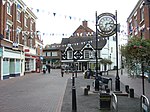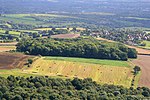Uriconian
Uriconian rocks are volcanic rocks found in parts of Shropshire, United Kingdom. The name relates to Uriconio, the Latin name for an Iron Age hillfort on the summit of the Wrekin, a hill formed of Uriconian rock. The Uriconian rocks of Shropshire (Wrekin Terrane) are thought to be potentially related to the Longmyndian Supergroup of the Stretton Hills, Shropshire, United Kingdom. Current geological profiling of the terranes suggests that the Uriconian rocks are of Precambrian age (Neoproterozoic Phases 2 and 3). The Uriconian Rocks outcrop to the southeast of the Long Mynd area of the Welsh Borderland Fault System and beyond the Church Stretton Fault which trends northeast-southwest across the area. The Stretton Hills are composed primarily of arenaceous (quartz rich sand) beds assigned to the Longmyndian Supergroup. The Longmyndian rocks are a c.6 km thick group of volcaniclastic and bentonitic sediment horizons. The Uriconian have long thought to be older than the Longmyndian and generally outcrop to the southeast of the latter within northeast-southwest trending lineaments suggesting basement influence for the regional structure.The Uriconian rocks outcrop in areas from Wellington, Shropshire to Primrose Hill on the southwest side of The Wrekin, east of Caer Caradoc and in the Craven Arms Inlier. Primarily the strata exist as fault-bounded slices within splays of, and to the southeast of, the main Church Stretton fault system. The Uriconian rocks comprise both intermediate to acidic and basic (bimodal) volcanic suites that reflect largely intraplate origins for the complex although some subduction signatures have been identified. Further work has led to suggest that the locality of this kind of volcanism is related to marginal basin volcanicity (behind the main arc) influenced by trans-tension brought about by oblique subduction.The Neoproterozoic sediments were deposited on Avalonia in various strike-slip faulted basins and they comprise predominantly volcaniclastic and siliciclastic sediments.
Excerpt from the Wikipedia article Uriconian (License: CC BY-SA 3.0, Authors).Uriconian
Ercall Lane,
Geographical coordinates (GPS) Address Nearby Places Show on map
Geographical coordinates (GPS)
| Latitude | Longitude |
|---|---|
| N 52.682 ° | E -2.529 ° |
Address
Ercall Lane
TF6 5AL
England, United Kingdom
Open on Google Maps








